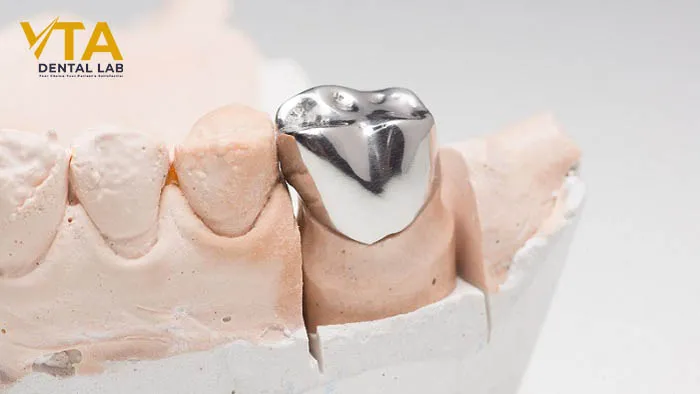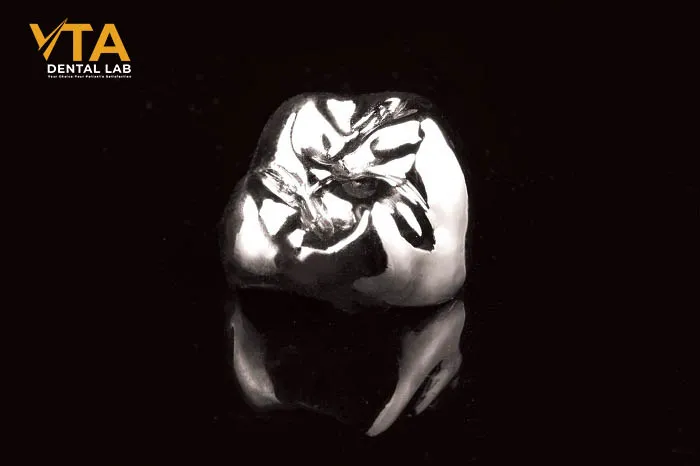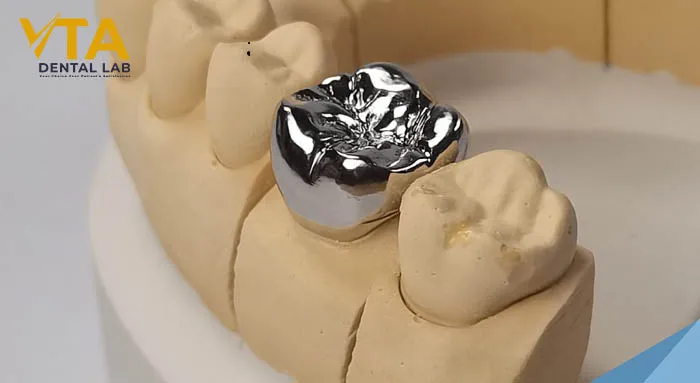Metal Dental Crowns: Pros and Cons and Considerations
Metal dental crowns remain a gold standard for posterior restorations due to their unmatched durability, precision fit, and long-term performance. While all-ceramic options have gained popularity for aesthetic cases, full-cast metal crowns still play a vital role in modern restorative dentistry, especially in areas with limited space and high functional demand.
What are metal dental crowns?
Metal dental crowns are durable and strong restorations that improve both the shape and function of decayed or damaged teeth. They protect teeth from further damage, and their precise fit helps prevent plaque and acids from entering cracks. In addition to filling gaps, metal crowns are used to cover implants, support dental bridges, and protect natural tooth structures.

Metal dental crowns offer lasting strength and reliability—ideal for restoring function to your back teeth
Today, various metals can be used to make dental crowns, commonly including gold, silver, platinum, palladium, nickel, chromium, cobalt, etc. Most crowns are not made from 100% pure metal, as many pure metals lack the necessary physical properties for functional crowns. For instance, some noble metals are soft, which makes them easier to work with during manufacturing, but they lack the structure needed for long-term performance.
Therefore, to enhance the structural integrity of metal crowns, studies have shown that mixing these metals with harder materials to form alloys is effective. As a result, some metal crowns may appear silver in color but are made from a mixture of silver and stronger metals like titanium. Gold crowns may also contain only a small amount of actual gold.
Special Considerations for Posterior Teeth
Metal dental crowns are especially ideal for posterior teeth, located away from the smile line, where space is often limited. These restorations are designed for a precise fit, offer excellent biocompatibility, and elicit favorable tissue responses to metal alloys, particularly gold, except in cases where patients are allergic to certain metals.

A classic choice for restoring back teeth with confidence
Advantages of Full-Cast Metal Dental Crowns
Full-cast metal restorations provide exceptional mechanical strength and are highly resistant to fracture or functional failure, making them an optimal choice for severely damaged molars. They are also a dependable option for full-cast fixed dental bridges.
To prepare a tooth for a full-cast crown, all axial walls and the occlusal surface must be reduced, which increases retention compared to more conservative restorations such as inlays, onlays, or veneers that preserve more of the natural tooth. In cases with furcation involvement, the buccal and lingual surfaces may be contoured to enhance access for hygiene and promote long-term periodontal health.

High noble yellow crowns are soft on opposing teeth, easy to polish, and highly biocompatible
Metal crowns—particularly those made from noble or semi-noble metals—are highly biocompatible. They are well-tolerated by gingival tissues, rarely cause allergic reactions, resist plaque accumulation, exhibit excellent wear resistance, and do not absorb fluids.
These crowns have high tensile strength, allowing them to be thinner than other restorations while still preserving more of the natural tooth structure. The durability of modern dental alloys enables our lab to fabricate significantly thinner restorations compared to porcelain-fused-to-metal (PFM) or all-ceramic alternatives.

Semi-precious metal crowns offer a balance between biocompatibility and affordability, commonly used in long-span bridges
Another major benefit is that metal crowns are extremely gentle on opposing teeth. With a wear factor close to that of natural enamel, they reduce the risk of excessive wear. When wear on opposing teeth is a concern, noble or semi-precious metals are preferred due to their softer, enamel-friendly properties while still offering long-term strength. Additionally, the coefficient of thermal expansion of noble metals closely matches that of natural enamel.
Disadvantages of Metal Dental Crowns
The main drawback of metal dental crowns is their appearance. Since metals are typically silver or gold in color, they are more visible in the mouth, especially in the smile zone. Crowns made from noble metals or gold can be expensive, depending on market prices.
In rare cases, minor gaps may occur after casting, potentially leading to secondary caries. However, softer noble metals may allow for minor post-casting adjustments.

Metal crowns are less aesthetic but outperform ceramics in durability, making them suitable for molars under heavy occlusal forces
When selecting a metal restoration, it is important to assess whether the patient has any metal allergies, particularly if noble or semi-noble options are not chosen. Base metal alloys often contain nickel, chromium, and other elements that can cause allergic reactions in sensitive individuals.
Partner with a Trusted Dental Lab
Please feel free to contact us for more detailed information. Our technicians have in-depth knowledge of modern metal alloys and are always available to discuss case-specific solutions.